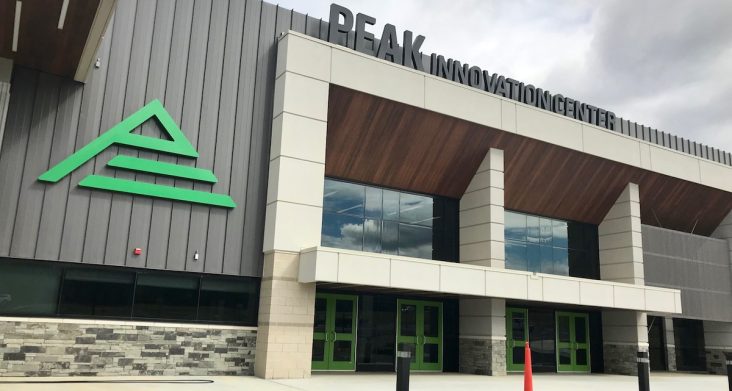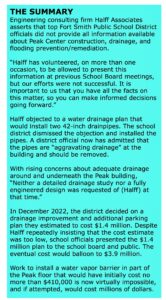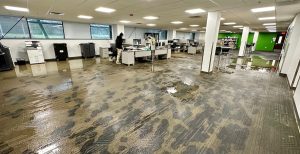Letter suggests Fort Smith School Board did not get all info about Peak Center issues
by May 17, 2023 9:12 pm 1,729 views

The engineering firm hired by Fort Smith Public Schools for consultation with the district’s Peak Innovation Center believes the FSPS Board of Education (BOE) was blocked by school officials from receiving critical information about flooding and flood prevention at the building.
Travis Brisendine, vice president and Fort Smith operations manager with Halff Associates (formerly Morrison-Shipley Engineers, Inc.), on May 12 sent a 24-page letter to school board members and the district expressing concern over “unique drainage challenges” at Peak and information that has been shared with the school board.
“The property on which the PEAK Innovation Center is located has some unique drainage challenges that were well known to us before construction began. Some of these have contributed to recent damages from record rainfall events. While there are several complicated factors that contributed to rising waters and subsequent damages at the PEAK facility, it is our concern that some have not been clearly articulated to the school board following these rainfall events,” Brisendine said in the letter.
Brisendine also notes that a detailed presentation for an August 2022 school board meeting was “trimmed down” by Shawn Shaffer, FSPS executive director of facility operations, against the wishes of Halff.
“We felt the information trimmed out was beneficial for the BOE to gain a full understanding of the site history as well as project timeline and construction,” Brisendine noted in the letter.
In the conclusion of the letter, Brisendine reiterated his belief that school officials did not provide the BOE with all the info they should have had to make project and funding decisions.
“It is our belief that important information regarding MSE/Halff’s 4.5-year involvement in the PEAK project has not been fully presented to the BOE. MSE/Halff was not hired as a drainage consultant nor tasked with drainage design until this year. Furthermore, FSPS budget constraints as well project timelines let to alternative damage remedies that were not recommended by MSE/Halff,” he wrote.
 Brisendine said Halff will attend a May 22 school board meeting and he hopes they will be given the time to present their concerns directly to school board members.
Brisendine said Halff will attend a May 22 school board meeting and he hopes they will be given the time to present their concerns directly to school board members.
THE FLOODING
Peak Innovation Center opened March 28, 2022, after numerous delays. Since its opening, it has flooded twice. The first occurred when record rainfall in Fort Smith caused flash flooding in the city June 7, June 8 and June 10 of last year. That incident caused flooding in the east parking lot of the facility. Water came into the Peak Innovation Center during the rainfall June 7 from two sources, according to FSPS reports.
A drainage project that includes an additional parking lot, approved by the school board in 2022, is expected to eliminate future drainage problems by raising the lower parking lot on the property and excavating the east field for a detention pond. At the time the board approved the project, it was estimated the cost of the drainage work would be about $1.1 million. Adding an additional parking lot was expected to cost $300,000.
At the school board’s regular meeting April 24, Joseph Velasquez, FSPS construction project manager, told the board the scope of work and the price tag had grown.
A storm on March 23 caused the second flooding incident. In this incident, water primarily entered inside the front office area and seeped into the adjacent hallway and near classroom areas, a statement from the district said. None of the classrooms experienced damage, and all classrooms were operational by March 27.
THE TIMELINE
In the letter to the school board Halff included a timeline of all events regarding Peak in which they were involved. An entry for March 24 states that MSE/Halff representatives arrived on site at 8:45 a.m. to investigate the conditions following the flooding at Peak. Shawn Shaffer, FSPS executive director of facility operations, and representatives from Conway-based Nabholz Construction, the construction manager at risk for the drainage and additional parking lot project at Peak, arrived on site shortly after to tour the facility and surrounding site to assess any potential flood-related damage.

“Mr. Shaffer reported that water entered the facility through joints in the floor slab and from several locations near the roof. It appeared that no storm water entered the building due to ponding water outside the building, however, significant ponding was present in the northeast parking lot,” the timeline states. “While on site, MSE/Halff expressed to Mr. Shaffer that the installation of the two (2) 42-inch pipes could be aggravating drainage at the site and recommended removing them as soon as possible. Mr. Shaffer agreed.”
On Dec. 6, 2021, Halff representatives met with Shaffer and others to discuss options for work being explored to create “safer” conditions for students in the building, the timeline states.
At the meeting, two remedial options were suggested by FSPS, and one possible solution was presented by Halff. Halff representatives “expressed concerns at this meeting regarding the inadequacy of either of the two options suggested by FSPS. MSE/Halff expressed preference for the solution that proposed a concrete box culvert approximately sized at 9-foot wide and 8-foot tall based on current knowledge of site hydrology/hydraulics, without the benefit of a detailed study. Neither a detailed drainage study nor a fully engineered design was requested of MSE/Halff at that time,” the timeline states.
At the end of 2021 and beginning of 2021, two 42-inch storm drain pipes were installed at Peak with the intent of solving some of the property’s drainage problems, “despite concerns expressed by MSE/Halff in the December 6th meeting,” the timeline states. Halff did not complete any design work before the two 42-inch pipes were installed.
Another issue mentioned by Shaffer when the March flooding occurred was that water entered the facility through joints in the floor slab, according to Halff’s timeline. This wasn’t the first time this occurred at the building. On May 4, 2020, it was reported that water was seeping upwards through joints in the building slab, the timeline said. In January 2021, an underdrain system was installed in an attempt to reduce subsurface water migration under the slab, and later reports to Halff show those drains appeared to be “successful at limiting the movement of subsurface water under the building slab,” the timeline states.
Representatives of Geotechnical and Testing Services, Inc. (GTS) of Fort Smith told the school board July 12, 2022, there was migration of water from a higher elevation and that was addressed through plans for grading and a drainage trench in the original design. But an under-slab moisture concern developed after construction began. GTS said the original concern about water issues was brought up by the general contractor – Turn Key Construction, who was the construction manager at risk for the phase one of the Peak project – when they began work to install new plumbing and made slab cuts and excavation shortly before February 2021.
“They had some water develop in their trenches, so that’s when they first saw some water and began their inquiry about what the source may be,” noted a GTS representative.
That representative later said they had encountered moisture in original soil borings before any construction began when a geotechnical investigation using several borings within the building footprint and exterior was done in April 2020. Page 24 of a geotechnical engineering report from GTS dated May 15, 2020, explains, “Additionally, due to the impermeable sandstone and shale layer anticipated to be near plan finished subgrade elevations below the future slab sections, we anticipate that the future floor slab will likely have a high moisture content and relative humidity unless site dewatering is successful. It is possible that the moisture within the existing or future floor slab section may cause problems with any adhesives or floor-covering material.”
IGNORED CONCERNS
As Talk Business and Politics reported in May 2022, district officials were not happy that Turn Key kept raising alarms about moisture under the building’s concrete floor. A letter from the district’s attorney, Marshall Ney, dated March 19, 2021, to Turn Key concerning the Peak project and water issues states: “While you state that Turn Key ‘repeatedly informed’ the District, Corgan, and HPM of the existence of a moisture problem and subsurface conditions, the truth is that the District has long been aware of moisture and subsurface conditions that needed to be addressed during the construction process.”
But that awareness did not result in taking actions suggested by consultants and others.
Turn Key told the district in 2020 the moisture issue could be resolved with a new slab that included a moisture barrier. While that option would have cost the district no more than $410,000, it could have been completed in eight weeks and would not have significantly delayed construction, Turn Key officials said. That work is now virtually impossible and would cost millions of dollars if an engineering solution could be found.
Turn Key owner Sandy Dixon, who is now a member of the school board, told Talk Business & Politics that the letter from Halff confirms the issues she repeatedly raised with top school officials and board members about flooding, drainage and water under the floor. Dixon said she and her construction superintendents were ignored or told to keep quiet about their concerns.
When Shaffer notified Halff June 7, 2022, that water had entered the building at various locations following significant rainfall events in the area, the Halff represented learned that a concrete trickle channel included in the original plans for the building that was intended to be built along the north face of the building had not been built. The intent of this trickle channel is to improve the conveyance of surface drainage from that area due to the flat slopes present. When Halff asked about the channel, they were told this concrete channel may have been omitted as a cost savings item.
‘TRIMMED’ INFORMATION
In the timeline Halff presented, it is noted that sections of their report on the June 2022 flooding were left off and that only slides that contained options for drainage improvement were included when the report was presented to the school board on Aug. 22.
“We felt the information trimmed out was beneficial for the BOE (Board of Education) to gain a full understanding of the site history as well as the project timeline and construction,” the timeline states.
Halff was not asked to attend any BOE meetings after Aug. 22, although Halff continued to meet with FSPS staff to finalize the scope of chosen drainage improvements. During those meetings, Halff told FSPS staff multiple times that the $1.4 million budget for proposed improvements might not cover the work needed. The approved project was to raise the lower parking lot and excavate the east field for a detention pond.
At the April 24 school board meeting, Velasquez presented a project that adds more flood control and would increase parking to 460 from 166. That project will be divided into three phases. Phase 1 includes the northeast drainage project and parking. It would add 155 parking spaces (124 new and 31 resurfaced), which Velasquez says was needed now that the community room has opened for public use. It also would create a detention pond, reroute and capture water under the new parking, add a new drive and trickle channel to the north. Cost of Phase 1 is estimated at $2.3 million.
Phase 2 would create 87 more parking spaces, a detention pond required by the city because of the additional hard space parking and a new drive to west parking. Cost is estimated at $858,426. Phase 3 would create 80 parking spaces, rework existing drive and rework west end to improve traffic flow. It has an estimated cost of $733,692. The total cost for all three phases is $3.928 million, Velasquez said.
“Halff has volunteered, on more than one occasion, to be allowed to present this information at previous School Board meetings, but our efforts were not successful. It is important to us that you have all the facts on this matter, so you can make informed decisions going forward,” Brisendine said in his letter. “The most recent school board meeting held on April 24, 2023, again included discussions and commentary without Halff having the benefit of sharing critical information we feel is necessary for you to fully understand the progression of events and project details leading up to today.”
FSPS administration has not responded to the letter from Brisendine or about the information provided in it.
“We are still reviewing the May 12, 2023 letter that was emailed to the FSPS Board of Education. The letter is addressed specifically to board members, so it would not be appropriate for staff to comment on behalf of the board members,” said Shari Cooper, FSPS director of communications.
Link here for a PDF of the Halff letter.
